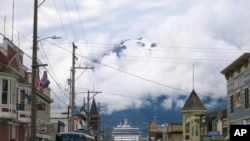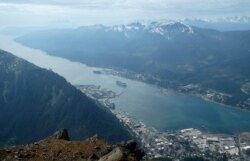Popular cruises up Canada’s scenic Pacific coast to Alaska have become the latest victim of the coronavirus pandemic, creating a new source of friction between Canada and the United States.
Canada’s Transport Ministry announced last week it was extending a prohibition of passenger cruise vessels carrying more than 100 people visiting its ports through the end of February 2022, effectively canceling the 2021 Alaska cruise season and cutting off an important source of revenue to the northernmost U.S. state.
The reaction from Alaska was swift and predictable. In a terse statement, the state’s two U.S. senators and sole member of the House of Representatives charged that the decision was made arbitrarily with no consultation or advance notice. The statement also said it was made with no consideration for Alaska or its economy.
The cruises, which weave through a network of coastal islands amid glaciers, fjords and towering pristine forests, are highly popular. According to the Alaska Travel Industry Association, the cruises accounted for 1,331,600 or 60% of all visitors to the state in 2019.
Last year, the state had projected a further 5% increase in cruise passengers before all sailings were canceled. Alaska tourism has been further set back by a closing of land borders between Canada and the United States.
Sarah Leonard, CEO of the Alaska Travel Industry Association, told VOA she was not surprised to see the ban on the cruises extended but had not expected it to last for so long.
She called for U.S. government assistance to heavily impacted businesses and workers and suggested a temporary waiver to the Passenger Vessel Services Act that will allow cruise ships to sail from American ports, like Seattle, directly to Alaska without stopping at Canadian ports.
The act, established in 1886, prohibits cruise ships from sailing directly between American ports. This means Alaska-bound cruise ships must embark from Canada or stop at a Canadian port like Vancouver.
“We've long advocated since the beginning of the pandemic for a potential temporary waiver of that federal legislation, which would again potentially allow large ship cruise passengers or large ship cruise operations to travel to Alaska,” Leonard said.
One of the major stops for the cruise ships is the small town of Skagway, Alaska, with a population of 1,000 people. Located within the so-called Inside Passage on the Alaska panhandle, it often sees upwards of 20,000 cruise visitors a day during the travel season.
According to the Alaska Visitor Volume Report, more than 1 million cruise passengers visited Skagway during the summer of 2019.
Skagway Mayor Andrew Cremata says cruise passengers normally account for 95% of the local economy, representing some $160 million in revenue for local businesses. He says writing a strongly worded letter to the Canadian government is not going to help Skagway.
“There's nobody living here in Skagway that isn't feeling the effects in some way,” said Cremata, who, besides being mayor, works as a part-time tour guide during the cruise season.
“I mean, there are people, you know — my wife has a full-time job still and I have a lot of work, I'm able to get online — but we were definitely impacted,” he told VOA. “Some people, if they made their primary income from tourism, you know, they're devastated.”
Like Leonard, Cremata would like to see more federal stimulus money from the U.S. government and a waiver to the Passenger Vessel Services Act.
It is not only Alaska that will feel the loss of the passenger cruises. The Canadian city of Vancouver is the main starting point for most ships heading to ports of call in Alaska, with nearby Seattle providing competition.
According to the Port of Vancouver, 2019 was a record-breaking year with more than 288 cruise ship visits — a 22% increase from the previous year. The season for Alaska-bound cruise ships usually runs from the beginning of April to the end of October.
Walt Judas, CEO of the Tourism Industry Association of British Columbia, worries that any temporary waiver to the Passenger Vessel Services Act might become permanent, meaning potential disaster for tourism in Canada’s westernmost province.
“Once you set a precedent like that, even if only on a temporary basis, who's to stop a lobby from making that permanent? And so that would be a big concern, if you start to sail from, say, Alaska to Seattle, and vice versa, and you cut out the Canadian ports,” said Judas. “Now, you've lost a huge amount of business for the visitor economy. And for the economy in general. We're talking more than $2 billion [Canadian] in economic impact.”
Like many in the tourism industry, the length of the closure took Judas by surprise.
He is still hoping, with enough pressure on the Canadian government and positive developments in the fight against the coronavirus pandemic, that the decision might be reversed in time to salvage some part of this year’s cruise season.
“We hope that we can see some progress in the months ahead and try to work with government on the criteria by which we could see a partial cruise season before the end of the year,” he said.
Tourism Vancouver, the city’s convention and visitors bureau, estimates each ship’s visit brings upwards of $2.2 million in immediate spin-off benefits, including stays in local Vancouver hotels. Many visitors continue on to visit other areas in the region.
To make matters worse, the Vancouver convention and conference business has virtually disappeared, furthering the economic impact of the pandemic on the local tourism industry.








